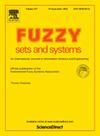模糊幸福模型中的弹性情绪动力学:认知和非认知视角
IF 2.7
1区 数学
Q2 COMPUTER SCIENCE, THEORY & METHODS
引用次数: 0
摘要
幸福模型使用一个微分方程来表达当外部力量改变时一个人的快乐感受。当人类感受到一种特定的情感时,很难用一个实数来描述它的强度,因为人类的情感是模糊的。用能够在数学上处理这种模糊性的模糊数来表达幸福程度是比较合理的,梯形模糊数是最适合的。本文应用模糊理论提出了弹性的指数函数。在考虑实际环境时,在考虑实际环境时应用正弦函数和高斯噪声。在像幸福模型这样的微分方程中,外力通常会随着时间的推移而减少,而不是具有恒定的周期性。因此,将模型表示为随时间趋近于零的弹性函数可能是合适的。在本文中,表示外力整体形状的函数定义为强制幂函数,该函数表示为随时间减小的指数函数。作为辅助函数,加入了正弦函数(波函数),并为随机性、不规则性或噪声项添加了高斯噪声项。我们用复模糊数和欧拉公式来表达人类情感在认知和非认知状态下的微分方程,以此来观察这种非线性现象。当人们感到快乐或悲伤时,他们在认知上知道为什么,但在某些情况下,当面对某种情况时,他们可能会感到比他们预期的更快乐或更悲伤。一个人的情绪可以被认为是一个人意识到的认知部分和人不意识到的非认知状态的复杂影响的结果。复数用来表示认知和非认知状态。复数的实部表示认知状态,虚部表示非认知状态。复数用欧拉公式表示,描述认知和非认知状态的混合结果。本文采用模糊动态幸福模型来观察人类情感,特别是非线性行为中混合结果的发生情况。最后,通过相图和分岔图观察了所提出的模糊动态幸福模型的非线性行为。本文章由计算机程序翻译,如有差异,请以英文原文为准。
Resilient emotional dynamics in a fuzzy happiness model: Cognitive and noncognitive perspectives
The happiness model employs a differential equation that expresses how a person feels happy when external forces change. When a human feels a specific emotion, it is difficult to express it with a real number to describe its intensity because human emotions are ambiguous. It is more reasonable to express the degree of happiness with fuzzy numbers that can handle this ambiguity mathematically, and trapezoidal fuzzy numbers are the most suitable for this. This paper proposes an exponential function for resilience by applying the fuzzy theory. In considering a real environment, a sinusoidal function and Gaussian noise are applied when considering a real environment. In differential equations, such as the happiness model, external forces often decrease over time rather than have a constant periodicity. Thus, it may be appropriate to express the model as a resilience function that approaches zero over time. In this paper, the function representing the overall shape of the external force is defined as the forced power function expressed as an exponential function that decreases over time. The sinusoidal function, a wave function, was added as an auxiliary function, and a Gaussian noise term was added for randomness, irregularity, or noise terms. We observe the nonlinear phenomenon by expressing differential equations representing human emotions in cognitive and noncognitive states using complex fuzzy numbers and Euler’s formula. When people feel happy or sad, they cognitively know why, but in some cases, when faced with a certain situation, they may feel happier or sadder than they expected. A person’s emotions can be considered the result of a complex effect of the cognitive part, of which the person is aware, and the noncognitive state, of which the person is not aware. Complex numbers are used to represent cognitive and noncognitive states. The real part of a complex number represents the cognitive state, and the imaginary part represents the noncognitive state. Complex numbers are expressed using Euler’s formula to describe the mixed results of cognitive and noncognitive states. This paper uses a fuzzy dynamic happiness model to observe how mixed results occur in human emotions, especially nonlinear behavior. Finally, nonlinear behavior is observed through phase portraits and bifurcation diagrams for the proposed fuzzy dynamic happiness model.
求助全文
通过发布文献求助,成功后即可免费获取论文全文。
去求助
来源期刊

Fuzzy Sets and Systems
数学-计算机:理论方法
CiteScore
6.50
自引率
17.90%
发文量
321
审稿时长
6.1 months
期刊介绍:
Since its launching in 1978, the journal Fuzzy Sets and Systems has been devoted to the international advancement of the theory and application of fuzzy sets and systems. The theory of fuzzy sets now encompasses a well organized corpus of basic notions including (and not restricted to) aggregation operations, a generalized theory of relations, specific measures of information content, a calculus of fuzzy numbers. Fuzzy sets are also the cornerstone of a non-additive uncertainty theory, namely possibility theory, and of a versatile tool for both linguistic and numerical modeling: fuzzy rule-based systems. Numerous works now combine fuzzy concepts with other scientific disciplines as well as modern technologies.
In mathematics fuzzy sets have triggered new research topics in connection with category theory, topology, algebra, analysis. Fuzzy sets are also part of a recent trend in the study of generalized measures and integrals, and are combined with statistical methods. Furthermore, fuzzy sets have strong logical underpinnings in the tradition of many-valued logics.
 求助内容:
求助内容: 应助结果提醒方式:
应助结果提醒方式:


